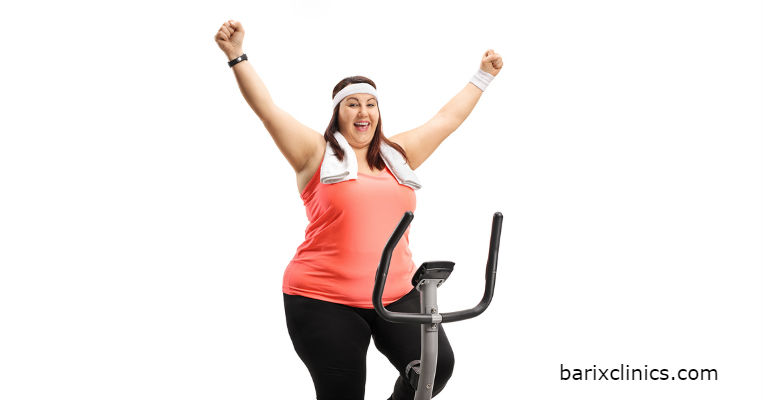Rein In Hunger
You would think that hunger is pretty straight forward—you get hungry and you eat, but it is much more complicated than that. After weight loss surgery, many find that hunger is not the strong driving force to eat that it used to be. In fact, many need to find ways to remember to eat. Unfortunately, some find that wonderful respite from hunger that helps you control what you eat can wane over time. But, don’t fear…there are strategies that can be used to keep hunger in line and you in control.
Download On Track with Barix: Rein in Hunger
How Hunger Works
Our body gives us signals that tell us it is time to eat and signals to stop eating when we’ve had enough. Here is a very basic overview of how it works. Foods that we eat supply our bodies with energy (calories) from fats, proteins, and carbohydrates. When we eat, the stomach expands. This stretching causes the nerves in the stomach and small intestine to send signals to the brain to stop eating. As the nutrients from the food enter the small intestine, more signals are sent to the brain to stop eating. Those nutrients are then absorbed from the small intestine and enter the bloodstream and the brain receives additional stop-eating signals. Eventually, as nutrients are moved into cells for energy or storage, blood sugar levels drop, hunger signals are sent to the brain and the cycle starts all over again.
This process is controlled by complex interactions between several hormones. These hormones are designed to work in balance to insure that we eat just enough food to fuel our bodies. And for most of history, they have done just that. Look back at pictures from the 60’s or before—it was rare to see someone overweight, much less severely obese.
Our current food environment overpowers the natural systems our bodies have in place and causes us to eat more than we need. Understanding how our body works, we can learn strategies to reduce the power of our environment and help our natural hunger and satiety controls be more effective.
Hormones
Looking at the different hormones, you can see just how complex the body’s hunger/satiety system is. Here is a brief description of the major players and how they work.
Leptin: Reduces Appetite
Leptin is produced by fat cells and notifies the brain that there is enough fat in storage and it is time to stop eating. More leptin is produced as fat cells grow, triggering a decrease in food intake. When fat stores shrink, as weight is lost, less leptin is released and an increase in food intake is stimulated.
Dysfunction can occur when the body becomes resistant to leptin, typically due to obesity or chronically elevated insulin levels, and the signal to stop eating doesn’t register.
Ghrelin: Increases Appetite
Ghrelin is produced in the stomach. When the stomach is empty, ghrelin is secreted signaling the brain that it is time to eat. The secretion stops when food causes the stomach walls to stretch.
Dysfunction occurs when you cut calories by dieting. One study found a 24% increase in ghrelin after a 17% weight loss—it’s hard to keep the calorie intake down with raging ghrelin levels.
Gastric bypass patients benefit from a lower ghrelin level and that may explain the lack of appetite that many feel. One study looked at ghrelin levels in obese individuals before and after gastric bypass surgery and found a 30% decrease after surgery.
With 80% of the stomach removed after gastric sleeve surgery, it is not surprising that ghrelin levels are reduced. Six months after surgery, ghrelin levels were about one half of their pre-surgery level.
Insulin: Regulates Blood Sugar
The pancreas secretes insulin when blood sugar levels rise. Insulin’s role is to move sugar from the bloodstream into the cells where it can be used for energy.
Dysfunction occurs when a food or beverage high in concentrated sugar is consumed. This results in too much insulin being released and once the sugar has been moved from the bloodstream into the cells, a higher level of insulin remains in the bloodstream triggering hunger.
With obesity or chronic high insulin levels, the body can become resistant to insulin—so even if the body produces adequate or excessive insulin, it isn’t able to be used to move blood sugar from the bloodstream into the cells to be used for energy and diabetes may develop.
Adiponectin: Reduces Appetite
Adiponectin is another hormone produced by fat cells. This powerful hormone improves insulin sensitivity, reduces inflammation, increases the rate at which the body uses energy, and reduces appetite—wow!
It seems, based on what we know, that a higher adiponectin level is desirable for those wanting to reach and maintain a healthy weight. We do know that higher levels of adiponectin are found in those with a normal weight, athletes, and those without diabetes. We do know that adiponectin is increased with weight loss and certain diabetes medications. Unfortunately, there are no legitimate adiponectin supplements available.
But, you may be able to increase adiponectin levels through your lifestyle. It appears that a diet rich in mono-unsaturated or healthy fats, fiber, and lower in simple carbohydrates and saturated fat seems to be associated with a higher adiponectin level. Exercise may also increase adiponectin.
A very interesting study found a fairly wide range of adiponectin levels in gastric sleeve patients 12 months after surgery. Those with higher adiponectin levels had lower appetites. Higher adiponectin levels are also expected after gastric bypass surgery.
Peptide YY (PYY): Reduces Appetite
PYY is a hormone secreted by the small intestine that signals the brain to stop eating. Obese individuals seem to have less PYY than normal weight people. Low Peptide YY concentrations are associated with an increase in appetite and food intake.
Histamine and serotonin: Reduces Appetite
These hormones work to control hunger. Antihistamines may remove the appetite reducing power of histamines. Higher levels of serotonin tend to produce a calm mood, sleepiness and decrease the desire to eat.
Other Factors
In addition to all of the hormonal influence on hunger, there are cultural, psychological, and environmental factors that also play a role.
Sleep
Sleep, or rather a lack of adequate sleep, affects the hunger/satiety system. Study after study supports the idea that a lack of sleep triggers reactions that lead to weight gain. Researchers have found a decrease in the appetite controlling hormone leptin and an increase in the appetite enhancing hormone ghrelin in those with chronic sleep loss (5 hours of sleep a night). Other studies support this by showing an increase in food intake and cravings following just a single night of inadequate sleep.
Stress
Stress levels can affect hunger. A higher level of the stress hormone cortisol, in those genetically prone to obesity, may cause an increase in hunger. In addition to the increase in hunger, many have learned responses to stress that including eating not-so-healthy foods. Learning new techniques to manage and respond to stress, such as exercise, relaxation techniques, time management and a change in outlook may reduce stress-induced overeating.
Variety
Variety is the spice of life, right? Well maybe not when it comes to weight control. It seems that variety in the form of taste, texture, color and/or temperature stimulates the senses and increases food intake. And that makes sense—you can only eat so many raw almonds, but if you have an entire buffet of food to choose from, it is hard not to overeat.
Comfort
Food has been paired with the rewards of comfort, nurturing, and positive social experiences over the years.
External Cues
The external cues of time, smells and visual cues can have a huge impact on the desire to eat. Some individuals have a stronger response to external cues than others. Have you ever felt that you could gain weight by just walking by a bakery? You may not be too far off–studies show that in some individuals, the smell, sound and visual cues of a steak grilling raises insulin levels. And when insulin levels are high so is appetite.
Many things in our environment impact our desire to eat–the availability of food (it is everywhere—isn’t it?), social gatherings, mood, fatigue, emotions, and even the temperature.
Strategies for Optimal Food Intake
You’ve already taken the biggest step to optimize food intake by having bariatric surgery. Nothing else gives you the tool to take control of your eating so you can reach and maintain a healthy weight.
Let’s look at some other strategies that will help you eat the right amounts of the right foods. You’ll need to develop skills, engage in healthful lifestyle habits, and manage high-risk situations to maximize the effectiveness of bariatric surgery.
Choose Healthy Foods–Eat balanced meals and snacks of fresh, unprocessed foods that include a good protein source, fiber-rich foods (like fresh vegetables and fruits) and healthy fats. These foods don’t over stimulate the reward center of the brain like highly processed foods can—causing you to crave more and more.
Eat Solid Food–Liquids and many crunchy snack foods empty out of your stomach quickly, leaving you looking for more to eat before you next meal/snack time. A protein supplement may not be the best breakfast if it doesn’t satisfy you until your next scheduled meal or snack. You may feel more satisfied eating solid foods like a scrambled egg with cheese.
Eat Six Small Meals-Small, frequent meals help to keep blood sugar levels even and can reduce hunger. Each meal should include a source of protein and/or fat. For example, put a little peanut butter on an apple to help stabilize blood sugar and prolong the sense of satisfaction. Eat every 2 ½ to 3 hours.
Protein First–Start each meal with a “firm” source of protein. Firm foods will stay in the pouch or sleeve longer, providing a sense of satisfaction. Monitor and meet your protein goal daily.
Limit Simple Carbs–Simple carbs in the form of sweets, crackers, cereals, breads, snack foods, sweetened beverages and juice should be limited. Instead get your carbs from fresh vegetables, low fat dairy, fresh whole fruits, and small amounts of whole grains.
Set Up Your Environment for Success–Stock your kitchen and office with healthy meal and snack options. Put those foods front and center where you will see them first. Don’t bring tempting foods into your home. Meal plan and prep so it is easier for you to eat right. Pay for gas at the pump. Prepare a no-added-sugar treat for celebrations. Invest a little time to think through the circumstances that cause you to want to make less-than-healthy choices and then seek to control those situations by pre-planning.
Use the 5/30 Rule–Drink up until 5 minutes before your meal. Stop and don’t resume until 30 minutes after you are done eating. This will minimize pushing the food out of the pouch or sleeve—potentially allowing you to eat more and long-term stretching out the stomach or the stoma.
Take Time–Slow down, take small bites and chew foods to a paste-like consistency. This helps you to get the signal that you’ve had enough and prevents discomfort.
Log it–A food log keeps you keenly aware of what you are eating. It also teaches portion sizes and the protein and calorie content of foods.
Adequate Sleep-Life is busy and life is stressful so we go, go, go. Our health depends on taking the time to stop, sleep and refresh. If not, we face mounting health issues. There are times in our lives, like having a new baby, that reduce our ability to get enough sleep. But, beyond those kinds of events, most of us have the opportunity to craft our lives in a way that allows us to get 7-9 hours of sleep a night. Make sleep a priority to keep your appetite under control and so much more.
Exercise–It’s a fact, exercise makes you feel better. When you feel better, you are more likely to make healthier decisions. You’ll burn a few calories, improve your insulin resistance, and maybe even bump up your level of adiponectin (Remember that awesome hormone that curbs appetite, fuels fat burning, and reduces insulin resistance?).
Muffin Tin Meals: Enchiladas
1/3 cup uncooked quinoa
2/3 cup water
1 ½ tablespoons minced garlic
1/2 cup finely chopped yellow onion
1 red or orange pepper, finely diced
1 teaspoon olive oil
1 teaspoon cumin
1 teaspoon dried oregano
1 teaspoon chili powder
1 teaspoon hot sauce (optional)
1 teaspoon red pepper flakes (optional)
1/2 cup fresh cilantro, chopped
3/4 cup red enchilada sauce, divided
1 pound extra lean ground beef
¼ cup egg substitute
2/3 cup reduced fat shredded Colby Jack cheese
In a small saucepan, bring water and quinoa to a boil. Reduce heat to low, cover and simmer for 15 minutes. Remove from heat and fluff with fork. Let cool for 5 minutes.
Preheat oven to 350 degrees F. Spray a 12-cup muffin tin with cooking spray. Place olive oil in a medium skillet and heat on medium. Add garlic, onion, and bell pepper cooking until onions have softened. Place in a large bowl. Stir in cooked quinoa, cumin, oregano, chili powder, hot sauce, red pepper flakes, cilantro, and ½ of enchilada sauce. Mix in ground beef, egg substitute and 1/4 cup of cheese.
Using a 1/4 cup measuring cup, scoop the meatloaf mixture evenly to muffin cups.
Bake for 25-30 minutes. Remove from oven, spoon remaining enchilada sauce and cheese over the tops of muffins and cook for an additional 3-5 minutes for the cheese to melt. Makes 6 servings.
Nutrition information per serving: 198 calories, 23 grams protein, 8 grams fat, 10 grams carbohydrate, 454 mg sodium.
Muffin Tin Meals: Southwest Meatloaf
1 1/2 pounds of extra lean ground beef
2 cups frozen corn, thawed
1/2 can of organic black beans, rinsed and drained
3 tablespoons fresh yellow pepper, chopped
3 tablespoons red onion, chopped
1- 4 oz can of green chilies
1/4 cup ketchup
1/2 cup sugar-free barbecue sauce
1 teaspoon Worcestershire sauce
1 egg
1/4 tsp salt
1/4 tsp pepper
Preheat oven to 350 degrees F. Spray a 12-muffin tin with cooking spray.
In a small bowl, mix together ketchup and sugar-free barbecue sauce and set aside. In a large mixing bowl combine ½ of the ketchup mixture and all other ingredients. Mix well.
Divide the meatloaf mixture evenly into 12 muffin tins. Bake for 30 minutes. Remove from oven, top with remaining ketchup mixture, and cook an additional 5 minutes. Makes 6 servings.
Nutritional information per serving: 282 calories, 32 grams protein, 6 grams fat, 24 grams carbohydrate, 474 mg sodium.




